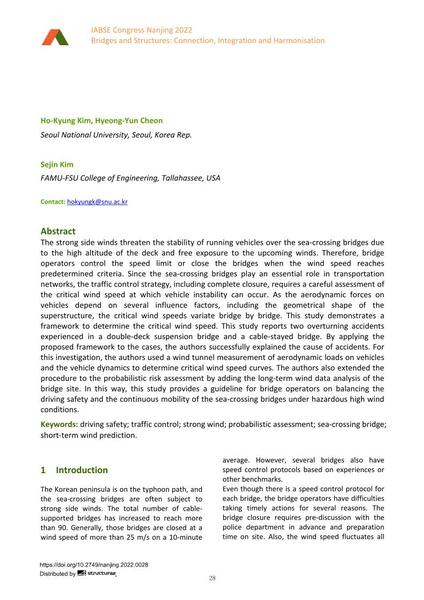Probabilistic Assessment of Vehicle Driving Safety under Strong Winds – Cause Investigations on Two Sea-Crossing Bridges

|
|
|||||||||||
Détails bibliographiques
| Auteur(s): |
Ho-Kyung Kim
Hyeong-Yun Cheon (Seoul National University, Seoul, Korea Rep.) Sejin Kim (FAMU-FSU College of Engineering, Tallahassee, USA) |
||||
|---|---|---|---|---|---|
| Médium: | papier de conférence | ||||
| Langue(s): | anglais | ||||
| Conférence: | IABSE Congress: Bridges and Structures: Connection, Integration and Harmonisation, Nanjing, People's Republic of China, 21-23 September 2022 | ||||
| Publié dans: | IABSE Congress Nanjing 2022 | ||||
|
|||||
| Page(s): | 28-33 | ||||
| Nombre total de pages (du PDF): | 6 | ||||
| DOI: | 10.2749/nanjing.2022.0028 | ||||
| Abstrait: |
The strong side winds threaten the stability of running vehicles over the sea-crossing bridges due to the high altitude of the deck and free exposure to the upcoming winds. Therefore, bridge operators control the speed limit or close the bridges when the wind speed reaches predetermined criteria. Since the sea-crossing bridges play an essential role in transportation networks, the traffic control strategy, including complete closure, requires a careful assessment of the critical wind speed at which vehicle instability can occur. As the aerodynamic forces on vehicles depend on several influence factors, including the geometrical shape of the superstructure, the critical wind speeds variate bridge by bridge. This study demonstrates a framework to determine the critical wind speed. This study reports two overturning accidents experienced in a double-deck suspension bridge and a cable-stayed bridge. By applying the proposed framework to the cases, the authors successfully explained the cause of accidents. For this investigation, the authors used a wind tunnel measurement of aerodynamic loads on vehicles and the vehicle dynamics to determine critical wind speed curves. The authors also extended the procedure to the probabilistic risk assessment by adding the long-term wind data analysis of the bridge site. In this way, this study provides a guideline for bridge operators on balancing the driving safety and the continuous mobility of the sea-crossing bridges under hazardous high wind conditions. |
||||
| Copyright: | © 2022 International Association for Bridge and Structural Engineering (IABSE) | ||||
| License: | Cette oeuvre ne peut être utilisée sans la permission de l'auteur ou détenteur des droits. |
||||
